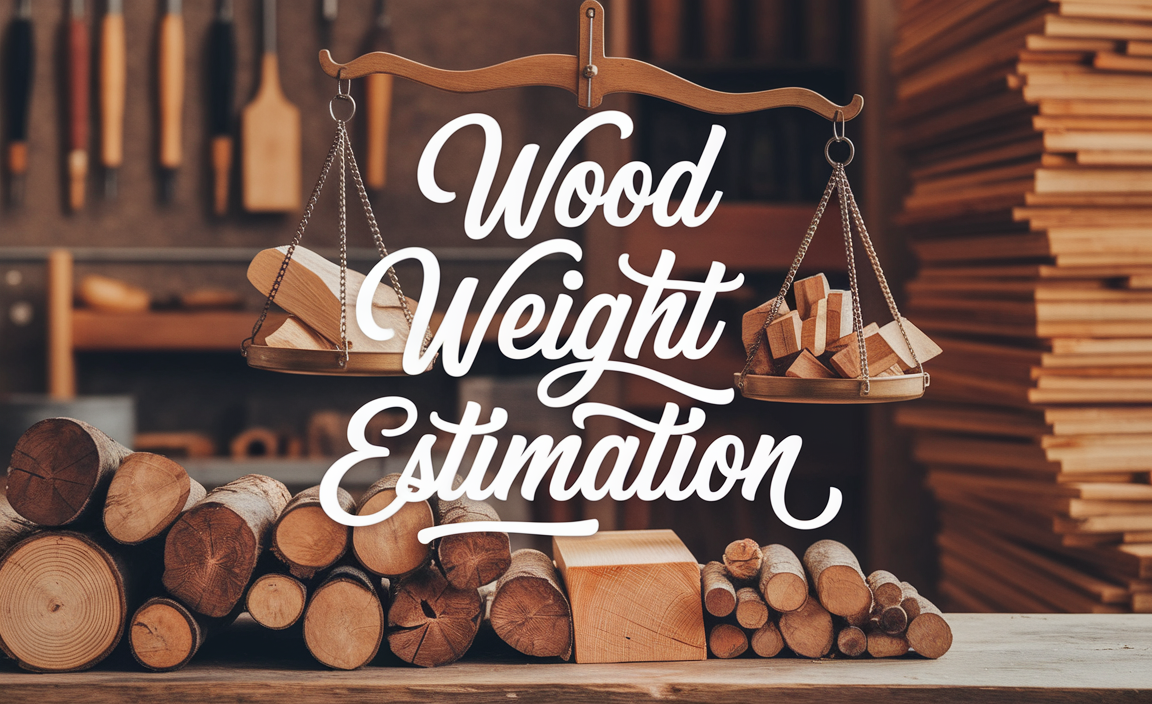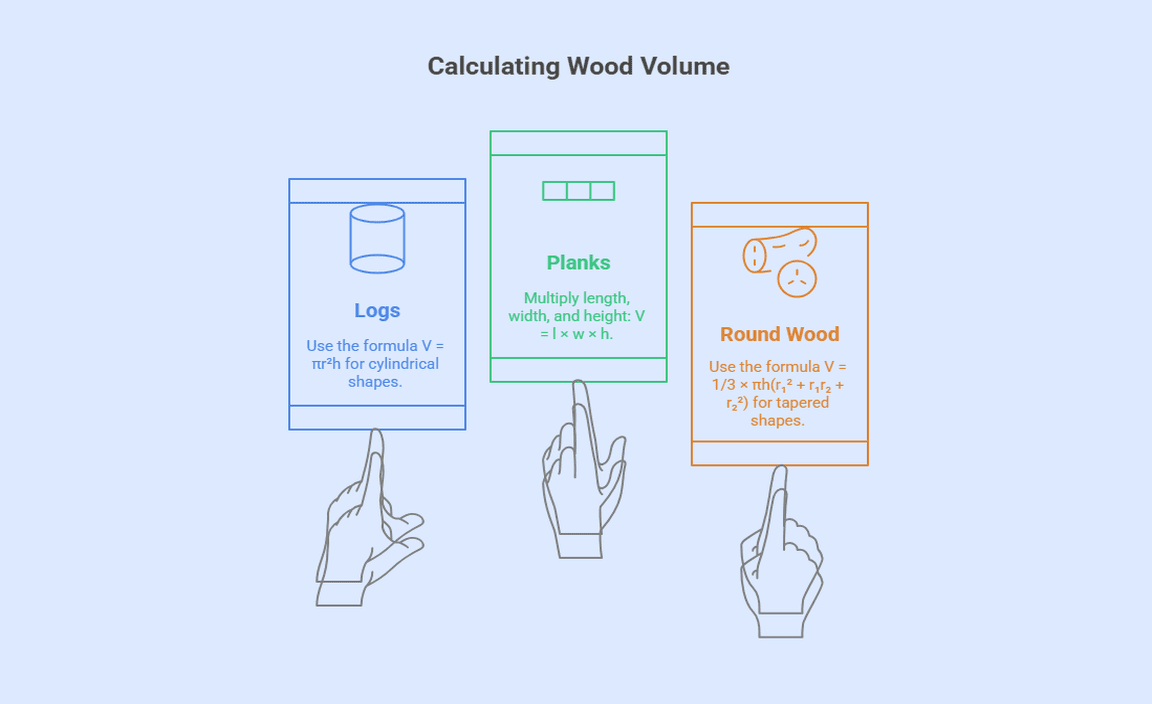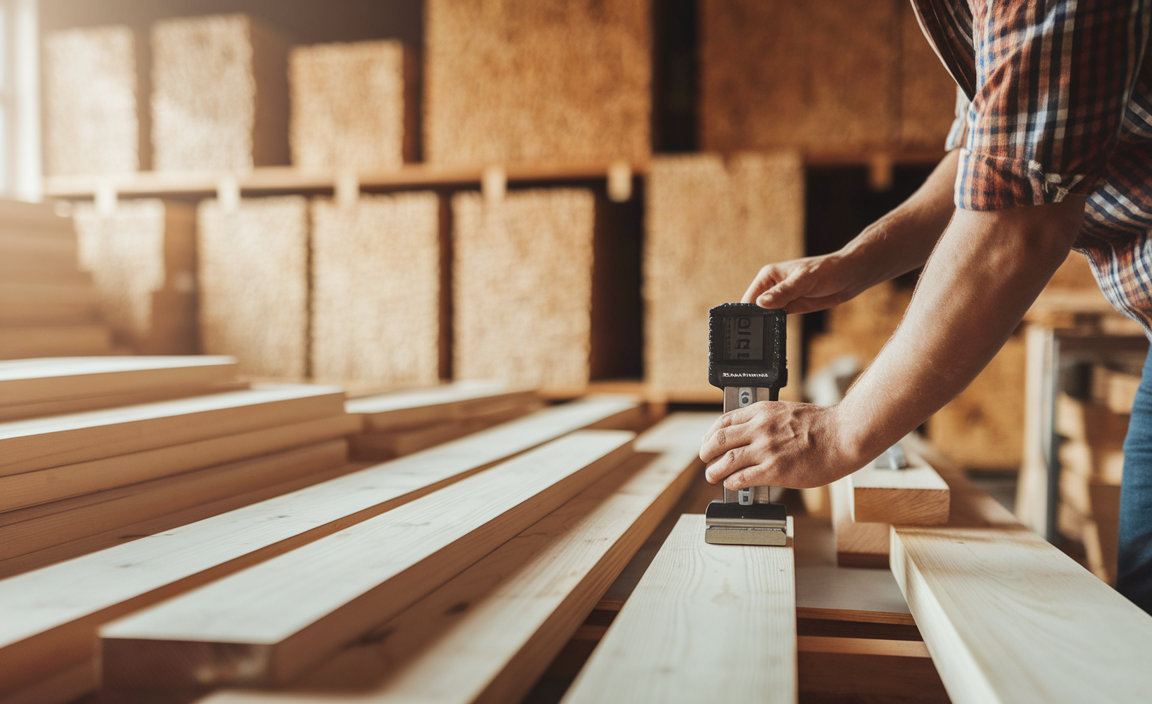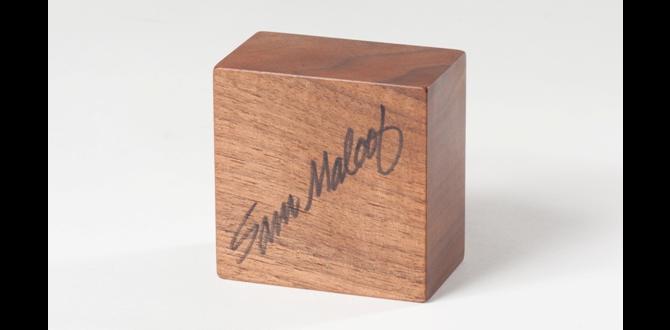Have you ever wondered how much a piece of wood weighs? Estimating wood weight can feel tricky. But it doesn’t have to be! Imagine you have a wooden plank. You want to build a treehouse. Knowing how much that wood weighs is essential for safety and planning.
Many people don’t realize that different types of wood have different weights. For example, a sturdy oak is heavier than a light pine. Isn’t that interesting? Most folks think all wood is the same, but that’s far from true.
In this article, we’ll explore wood weight estimation. You’ll learn how to calculate the weight of various wood types easily. You’ll also discover some fun facts about wood that might surprise you! So, let’s dive in and uncover the secrets of wood weight estimation together.

Table of Contents
Wood Weight Estimation: Accurate Methods And Techniques

Estimating the weight of wood can be simple and fun! Did you know that different types of wood have unique weights? For example, oak is heavier than pine. Knowing how to estimate wood weight helps in choosing the right materials for projects, like building a treehouse. You can use basic formulas to get a good idea of how much your wood will weigh. This knowledge can save time and effort in construction. Isn’t that neat?
Understanding Wood Density
Definition of wood density and its significance in weight estimation. Factors influencing wood density: species, moisture content, and age.
Wood density measures how much mass is in a given volume of wood. It helps us understand how heavy wood can be. This is important for wood weight estimation. Several factors affect wood density:
- Species: Different types of wood have different densities.
- Moisture Content: Wet wood is heavier than dry wood.
- Age: Older trees are often denser.
Knowing these factors helps in predicting wood weight accurately, which is useful for builders and carpenters.
What is wood density?
Wood density is the weight of wood divided by its volume. Higher density means heavier wood.
Calculating Wood Volume

Methods for measuring the volume of different wood shapes (logs, planks, etc.). Importance of accurate volume measurement in weight estimation.
Measuring the volume of wood shapes is important for finding their weight. Different shapes need different methods. Here are some common methods to measure wood volume:
- Logs: Use the formula V = πr²h, where V is volume, r is radius, and h is height.
- Planks: Multiply length, width, and height: V = l × w × h.
- Round wood: The formula V = 1/3 × πh(r₁² + r₁r₂ + r₂²) helps for tapered shapes.
Accurate measurements are key for better estimates. Relying on the right method can save time and resources. Think about how much easier finding the weight will be.
Why is accurate volume measurement important?
Accurate volume measurement ensures correct weight estimates, which helps in cost calculations and proper project planning. Without accuracy, projects may face delays or budget issues, making precise measurement vital.
Moisture Content and Its Impact on Weight
Explanation of how moisture content affects wood weight. Guidelines for measuring and interpreting moisture levels.
Moisture in wood plays a big role in its weight. Wet wood is heavier than dry wood. When wood has a high moisture content, it can weigh up to 30% more. This can make a difference in many projects. You can measure moisture content with a moisture meter. It gives you a quick reading. Wet wood often feels cool or damp. Dry wood feels warm and dry. Knowing this helps in choosing the right wood for your needs and understanding its weight.
How does moisture content affect wood weight?
Moisture adds weight to wood. It affects how heavy a piece will be for your projects.
Guidelines for measuring moisture levels:
- Use a moisture meter for quick results.
- Check for dampness by touch.
- Test multiple spots for accuracy.
Tools and Techniques for Weight Estimation
Recommended tools for calculating wood weight (scales, calculators, etc.). Stepbystep techniques for accurate wood weight estimation.
Estimating wood weight is important for many projects. To get it right, use the right tools and follow simple techniques. Here are some recommended tools:
- Scales: A scale helps measure the exact weight of your wood.
- Calculators: Use wood weight calculators online for quick estimates.
- Measuring Tape: Knowing dimensions helps in weight calculations.
Here’s a step-by-step method for accuracy:
- Weigh your wood using the scale.
- Measure its length, width, and height.
- Look up the wood type density.
- Multiply density by volume for the weight.
Practical Applications of Wood Weight Estimation

Importance in construction, carpentry, and woodworking projects. Implications for transportation and storage of wood products. Estimating wood weight has many real-world uses. For builders, knowing the weight helps in planning safe construction. If you use too much wood, it can lead to crooked houses. Woodworkers also need this info for their projects; lighter pieces are easier to maneuver. Plus, transporting wood? It’s crucial! Knowing the weight helps avoid overloading trucks, which is not only risky but can also result in extra fees.
| Use Case | Importance |
|---|---|
| Construction | Ensures safety and stability |
| Carpentry | Aids in project planning |
| Transportation | Prevents overload and extra costs |
Common Mistakes in Weight Estimation and How to Avoid Them
Identifying frequent errors made during wood weight estimation. Strategies for ensuring accurate calculations and assessments.
Estimating wood weight can be tricky. Many people make common mistakes. Here are some frequent errors and ways to avoid them:
- Ignoring moisture content. Wet wood weighs more than dry wood.
- Not measuring accurately. A small mistake can lead to big errors.
- Using the wrong formula. Know which formula suits your wood type.
To ensure correct estimates, always double-check your numbers. Use reliable sources for formulas. Remember, even small changes can affect weight. Stay focused!
What is a common mistake in wood weight estimation?
A frequent mistake is ignoring moisture content. Wet wood can weigh significantly more than dry wood. It’s essential to measure it properly for accurate weight.
Case Studies and Real-World Examples
Detailed examples of wood weight estimation in various industries. Lessons learned from practical applications and common challenges.
In many industries, estimating the weight of wood is crucial. For instance, furniture makers often need to know how heavy a piece will be for shipping. One study showed that a chair made of oak weighed around 30% more than one made of pine. This difference can surprise new builders, leading to unexpected shipping costs!
Here’s a simple table highlighting wood weights for common types:
| Type of Wood | Weight (lbs per cubic foot) |
|---|---|
| Oak | 47 |
| Pine | 35 |
| Walnut | 39 |
Real-world lessons show that wood weight can vary based on moisture content, which can lead to challenges. For example, wet wood is heavier. Think of it like carrying a wet sponge versus a dry one. Always double-check your estimates!
Conclusion
In conclusion, wood weight estimation helps you understand how heavy different types of wood are. Knowing a wood’s density is key to making accurate estimates. You can use charts or formulas to find this information easily. Next time you work with wood, remember to estimate its weight carefully. For more tips, you might want to explore additional resources on woodworking!
FAQs
Sure! Here Are Five Related Questions On The Topic Of Wood Weight Estimation:
Sure! Here are five related questions about wood weight estimation: 1. How do you find out how much wood weighs? 2. What types of wood are the heaviest? 3. Why is knowing the weight of wood important? 4. Can the moisture in wood change its weight? 5. How can we measure wood accurately? Let me know if you’d like me to answer any specific questions!
Sure! Please provide the question you’d like me to answer.
What Factors Influence The Weight Of Different Wood Species, And How Can These Be Used To Estimate Their Weight?
The weight of different wood species depends on a few things. First, the type of tree affects how heavy the wood is. Some trees, like oak, have denser wood, making them heavier. Second, the moisture content matters too. Wet wood weighs more than dry wood. We can estimate the weight by knowing the type of wood and its moisture level.
How Can Moisture Content In Wood Affect Weight Estimation, And What Is The Standard Procedure For Measuring It?
Moisture in wood makes it heavier. When wood has more water, it weighs more than dry wood. We can measure moisture by using a special tool called a moisture meter. To use it, you press the meter into the wood. It tells you how much water is inside. This helps us know the weight better!
What Formulas Or Methods Can Be Used To Calculate The Weight Of A Piece Of Dimensional Lumber Based On Its Volume?
To find out how much a piece of lumber weighs, you can use a simple formula. First, you need the size of the wood, which is its length, width, and height. Then, you can find the volume by multiplying these three numbers together. Finally, you multiply the volume by the weight of the wood per cubic foot, which is different for each type of wood. This will give you the weight of your lumber!
How Does The Density Of Hardwood Compare To Softwood In Terms Of Weight Estimation, And What Are Some Common Examples Of Each?
Hardwood is usually heavier than softwood. This means hardwood can weigh more when you measure the same size piece. Common examples of hardwood include oak and maple. Softwood examples are pine and cedar. So, if you’re picking wood for a project, remember that hardwood is denser and heavier!
In Woodworking And Construction, Why Is It Important To Accurately Estimate The Weight Of Wood Materials, And How Can Inaccurate Estimations Impact A Project?
Estimating the weight of wood is important because it helps us choose the right tools and plan how to carry it. If we guess wrong, the wood could be too heavy, and we might strain ourselves or break something. It can also affect how stable a building is or how well things fit together. By being accurate, we keep projects safe and successful!
Resource:
-
Wood Density Guide by The Wood Database: https://www.wood-database.com/wood-articles/density-of-wood/
-
Moisture Meter Usage Tips: https://www.popularwoodworking.com/article/using-a-moisture-meter/
-
How to Calculate Volume of Logs: https://forestryforum.com/members/donp/woodvol.html
-
Safe Handling and Transport of Lumber: https://www.osha.gov/etools/woodworking/material-handling





